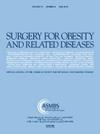Subjective improvement of reflux symptoms after conversion of sleeve gastrectomy to Roux-en-Y gastric bypass and concomitant repair of hiatal hernia
IF 3.5
3区 医学
Q1 SURGERY
引用次数: 0
Abstract
Background
Symptoms of reflux after sleeve gastrectomy (SG) are common and may be refractory to medical treatment.
Objectives
To assess outcomes of conversion of SG to Roux-en-Y gastric bypass (RYGB) with concomitant repair of hiatal hernias on symptoms of reflux.
Setting
Tertiary community hospital.
Methods
We reviewed data from all consecutive patients (2018–2021) who underwent conversion from SG to RYGB for refractory reflux symptoms. Concomitant hiatal hernias were diagnosed endoscopically or radiographically. Improvement in reflux symptoms, nausea, vomiting, dysphagia, or abdominal pain and postoperative proton pump inhibitor (PPI) use were compared with McNemar statistical test. Data are reported as mean ± standard deviation.
Results
In total, 64 patients (92% female; 48 ± 10 years) underwent conversion from SG to RYGB and repair of concomitant hiatal hernias 4 ± 3 years after the index SG. A hiatal hernia was detected preoperatively in 57 of 64 patients (89%) by either upper gastrointestinal contrast studies, computed tomography scan, or esophagogastroduodenoscopy. At 29 ± 14 months postconversion to RYGB, percent total body weight loss was 14 ± 9% and percent excess weight loss was 37 ± 29%, and body mass index decreased from 37 ± 7 to 32 ± 6 kg/m2. Symptoms of reflux and use of PPI improved during the early follow-up period (median: 14 months; P < .001) and was sustained at late follow-up (median: 32 months; P < .01). Improvement of nausea and dysphagia reached statistical significance at late follow-up (median: 32 months; P < .01). Vomiting and abdominal pain decreased with time but did not reach statistical significance. Postoperative complications were deep surgical-site infection (n = 3), pulmonary embolism (n = 1), bleeding (n = 5), reoperation (n = 3), and 30-day readmission (n = 6).
Conclusions
Conversion of SG to RYGB and repair of concomitant hiatal hernia improves reflux symptoms, nausea, and dysphagia, reduces PPI use, and confers additional weight loss.
袖带胃切除术转为 Roux-en-Y 胃旁路术并同时修复食管裂孔疝后反流症状的主观改善。
背景:袖带胃切除术(SG)后出现反流症状很常见,而且可能是药物治疗的难治性症状:目的:评估袖带胃切除术后转为 Roux-en-Y 胃旁路术(RYGB)并同时进行裂孔疝修补术对反流症状的影响:地点:三级社区医院:我们回顾了所有因难治性反流症状而从 SG 转为 RYGB 的连续患者(2018-2021 年)的数据。并发食管裂孔疝经内镜或放射学检查确诊。反流症状、恶心、呕吐、吞咽困难或腹痛的改善情况以及术后质子泵抑制剂(PPI)的使用情况通过 McNemar 统计检验进行比较。数据以均数±标准差表示:共有 64 名患者(92% 为女性;48 ± 10 岁)在接受 SG 手术 4 ± 3 年后,从 SG 转为 RYGB 并修补了同时存在的食管裂孔疝。64 名患者中有 57 人(89%)在术前通过上消化道造影、计算机断层扫描或食管胃十二指肠镜检查发现了食管裂孔疝。在转为 RYGB 后的 29±14 个月中,总体重减轻百分比为 14±9% ,超重百分比为 37±29% ,体重指数从 37±7 kg/m2 降至 32±6 kg/m2。反流症状和使用 PPI 的情况在早期随访期间有所改善(中位数:14 个月;P < .001),并在后期随访期间持续改善(中位数:32 个月;P < .01)。恶心和吞咽困难的改善在后期随访中达到统计学意义(中位数:32 个月;P < .01)。随着时间的推移,呕吐和腹痛有所减轻,但未达到统计学意义。术后并发症为手术部位深部感染(3例)、肺栓塞(1例)、出血(5例)、再次手术(3例)和30天再次入院(6例):结论:将 SG 转为 RYGB 并修复同时存在的食管裂孔疝可改善反流症状、恶心和吞咽困难,减少 PPI 的使用,并减轻体重。
本文章由计算机程序翻译,如有差异,请以英文原文为准。
求助全文
约1分钟内获得全文
求助全文
来源期刊
CiteScore
6.70
自引率
12.90%
发文量
570
审稿时长
56 days
期刊介绍:
Surgery for Obesity and Related Diseases (SOARD), The Official Journal of the American Society for Metabolic and Bariatric Surgery (ASMBS) and the Brazilian Society for Bariatric Surgery, is an international journal devoted to the publication of peer-reviewed manuscripts of the highest quality with objective data regarding techniques for the treatment of severe obesity. Articles document the effects of surgically induced weight loss on obesity physiological, psychiatric and social co-morbidities.

 求助内容:
求助内容: 应助结果提醒方式:
应助结果提醒方式:


